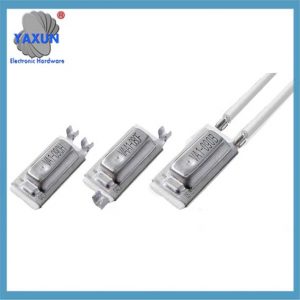速动恒温器/热保护器,在我们的所有控制器中具有最高的触点额定值. 适合使用于 120/240 交流负载. 可提供多种双金属元件以增强性能特征. 选择蠕变热保护器需要分析杆掷规格, 设定点温度, 滞后现象, 最大额定电流, 最大交流电压额定值, 最大直流电压额定值, 和开关寿命.
杆和直接规格
单极, 单掷 (单刀单掷) 开关在单个分支电路中建立或破坏单个导体的连接. 他们有两个终端,通常称为“单极”开关.
单极, 双掷 (单刀双掷) 开关使单个导体与另外两个单个导体中的任何一个都建立或破坏了连接. 通常称为“三向开关,SPDT设备具有三个端子,并成对使用.
双杆, 单掷 (DPST) 开关在单个分支电路中建立或破坏两个电路导体的连接,通常有四个端子.
双杆, 双掷 (DPDT) 开关在两个单独的电路中建立或破坏两个导体的连接. 大多数DPDT开关都有六个终端,并且有瞬间或维护的接触版本可用.
具有两个以上极线的蠕变热保护器被设计为将载荷分为单独的电路.
蠕变热保护器设定点温度
蠕变热保护器规范指南热开关和热保护器的设定点温度是固定的或可调节的场温度. 设定点是设备经历与电触点运动相关的状态变化的额定温度. 定点设备在给定温度下额定,而现场可调设备则具有可以调整设定点的温度范围.
蠕变热保护器滞后
迟滞, 也称为温差, 是发生切换的有限温度范围. 它旨在防止电路在状态之间不断变化. 滞后现象为 0.5 C 通常会启动 0.5 度超过设定点温度,并且不会再次更改状态,直到温度降至低于设定点温度 0.5C.
环境温度: 设备周围环境的正常或典型温度.
自动复位: 在出厂预设温度下自动重置其前触摸接触配置的恒温器.
双金属: 两种膨胀速率分子键合在一起的金属,形成恒温器的刀片或圆盘.
蠕变动作恒温器: 带有双重刀片的恒温器,可缓慢地使触点或慢慢打破触点.
电流求: 用来描述可预测条件的术语,其中增加的电流应用于恒温器会导致该设备在其设定点以下的温度下打开. 这种情况仅存在于正常闭合的双金属恒温器中.
功能温度: (TF的TF) 参考热截止, 由IEC标准定义, 在无负荷条件下热截止的温度打开电路的温度. IEC耐受性是 +0 C, -10 C.
保持温度: (TH或TH) 参考热截止, 热截止的最高温度可以在一段时间内保持额定电流 168 功能小时.
最高温度: (TM或TM) 参考热截止, 设备可以在10分钟内进行的最高温度,而无需恢复电导率.
最小差异: (也称为死班) 实际开放和实际的近距离温度之间的最低学位数量.
电机保护器: 对电流升高和温度升高敏感的热保护器.
常闭 (N.C.): 温度升高时接触开放.
常开 (不。): 温度升高时接触关闭.
一枪: 一个设备, 一旦在预设温度下激活, 不能重置. 仅在正常封闭的联系配置中可用.
额定电流: 设备可以携带的最大允许电流.
额定电压: 应应用于设备的最大电压.
自我保护者: 一个设备, 打开时, 无论环境温度如何. 仅在正常封闭的联系配置中可用.
快照恒温器: 具有双元元件的恒温器,该恒温元件在经历激活条件时捕捉接触. 这种结构允许负载的干净破裂.
热熔断器: 热切割是一种电气安全装置,当加热到特定温度时会中断电流.
热截止保险丝: 融化其内部元素以在温度过高的情况下打开电路的设备. 也称为热保险丝, 热保护器保险丝或热开关.
热保护器: 热保护器是一种内置在电动机中的保护装置,可提供过度或过度的保护器,如果内部温度上升到跳闸点之上,则可以断开镇流器的电源. 这可以保护电机免于过热. 开关类型包括自动休息, 手动重置和电阻温度探测器.
宽容: 允许范围以上和低于标称温度.
 English
English Afrikaans
Afrikaans العربية
العربية বাংলা
বাংলা bosanski jezik
bosanski jezik Български
Български Català
Català 粤语
粤语 中文(简体)
中文(简体) 中文(漢字)
中文(漢字) Hrvatski
Hrvatski Čeština
Čeština Nederlands
Nederlands Eesti keel
Eesti keel Suomi
Suomi Français
Français Deutsch
Deutsch Ελληνικά
Ελληνικά हिन्दी; हिंदी
हिन्दी; हिंदी Magyar
Magyar Bahasa Indonesia
Bahasa Indonesia Italiano
Italiano 日本語
日本語 한국어
한국어 Latviešu valoda
Latviešu valoda Lietuvių kalba
Lietuvių kalba македонски јазик
македонски јазик Bahasa Melayu
Bahasa Melayu Norsk
Norsk پارسی
پارسی Polski
Polski Português
Português Română
Română Русский
Русский Cрпски језик
Cрпски језик Slovenčina
Slovenčina Slovenščina
Slovenščina Español
Español Svenska
Svenska ภาษาไทย
ภาษาไทย Türkçe
Türkçe Українська
Українська اردو
اردو Tiếng Việt
Tiếng Việt



